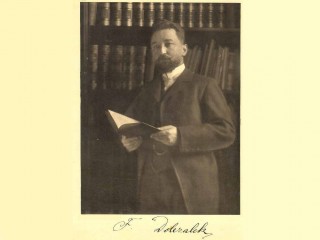
Friedrich Dolezalek biography
Date of birth : 1873-02-05
Date of death : 1920-12-10
Birthplace : Marmaros-Sziget, Hungary
Nationality : Hungarian
Category : Science and Technology
Last modified : 2010-05-19
Credited as : Chemical and electrical engineer, The quadrant electrometer, Technische Hochschule Hannover
0 votes so far
1900-11-01 Dolezalek started working with Friedrich Kohlrausch at the Physikalisch-Technische Reichsanstalt for about eight months.
1901-07-05 Dolezalek started working at Siemens & Halske on long distance telephone cables and on other electrical engineering subjects related to alternating currents.
After his habilitation at the Technische Hochschule Charlottenburg (Berlin) Dolezalek became professor at the Technische Hochschule Danzig (Easter 1904). Already in October 1904 Dolezalek was appointed extraordinary professor and director of the Gottingen physicochemical institute as successor of Walther Nernst (1905 -1907).
In April 1907 Dolezalek was appointed professor of physics at the Technische Hochschule Charlottenburg (Berlin) as successor of Heinrich Rubens. He worked on the theory of binary mixtures and concentrated solutions. In October 1912 he changed to the chemistry department and was appointed director of the electrochemical institute as successor of Franz Fischer (who was appointed director of the newly founded Kaiser-Wilhelm-Institut fur Kohlenforschung, Muhlheim).
Dolezalek initiated a new institute for physical chemistry and electrochemistry. Despite the war (1914 – 1918) and with enormous support from industry the institute became operational for the winter semester 1919. However, Dolezalek could enjoy his new institute only for about one year.
Friedrich Dolezalek died 1920-12-10 in Charlottenburg (Berlin) at age 47 (interestingly, the very same day Walther Nernst was awarded the Nobel Prize).
The electrometer is an instrument for measuring potential differences utilizing electrical attraction or repulsion. Friedrich Dolezalek (1873-1920) invented this form of quadrant electrometer using a quartz fiber suspension. A slight rotation of the electrodes is registered as a motion of a light beam reflected from a small mirror mounted on the suspension fiber.
The quadrant electrometer may be used to compare the EMF of two cells; verify Ohm’s Law; measure a high resistance; compare large and small capacitances and determine the dielectric constant. This is done by deflection of the aluminium vane via a difference in the electric potential of the pairs of quadrants. The angle of deflection is measured by shining a lamp on the mirror, which reflects the light onto a scale placed a certain distance away. The instrument must be calibrated so that the scale used is accurate and its sensitivity known but it draws no current from the circuit and is sensitive to a fraction of a volt.
The Dolezalek quadrant electrometer differs from previous designs in several respects:
1. The vane is lighter. It was usually made of paper coated with a thin layer of metal (e.g. silver) although thin aluminum was sometimes used. Older vanes were solid metal.
2. The quadrants are smaller.
3. The mirror and vane were suspended by a metal coated quartz fiber rather than a phosphor-bronze strip.
4. The Leyden jar beneath the quadrants has been eliminated.
The standard role of an electrometer in radiation measurements has been to measure the extremely small currents produced by an ion chamber – if the currents were sufficiently large, a galvanometer could substitute for the electrometer. In the early 1900’s the Dolezalek quadrant electrometer, invented at more or less the same time that Roentgen discovered x rays, was the instrument of choice. It employed a butterfly-shaped vane suspended inside four brass quadrants.
As the collected charge from the ion chamber changed the electrical balance between the quadrants and the vane, the latter rotated. A beam of light was reflected off a mirror attached to the vane’s suspension wire, and as the vane rotated, the reflected beam moved across a scale, often positioned one meter away. The time it took the reflected beam of light to move across a specific number of divisions on the scale served as a measure of the ion chamber’s current.
The Dolezalek electrometer might have been beautiful to look at, but it was difficult to set up and susceptible to static electricity and vibrations. Ultimately, it would be replaced by easier to use and less expensive devices such as the Wulf string electrometer (Wulf 1914) and the Lindemann torsion electrometer (1924). With these types of instruments, the movement of a fine fiber across a scale was monitored using a microscope.
















